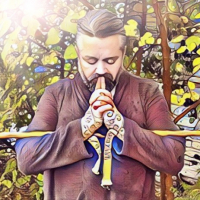- Posts: 3208
Basic Art of the Sword and Light saber Combat
baru wrote: check out Cold Steel. Look at their plastic training swords. I use them all the time. I highly recommend them.
It's true that these products are darn near unbreakable, but I will warn this. If what you want is something that moves and feels similar to a forged steel blade then they are not the best solution (at least for their products shaped like Japanese blades). They have too much flex and they are too light. However, if accurate representation of steel blades is not your concern then they are great. Always remember your purpose.
As for training tips, as someone who has trained in/taught martial arts for around twenty years I HIGHLY recommend finding competent instruction. There are individuals who can be self taught and actually be very very good but they are few and far between. You can get a decent basic understanding on your own but it's hard to progress beyond that. I've also found that source material for self training is less than complete.
Please Log in to join the conversation.
I studied Shinkendo for a little while, based on samurai styles. We used bokken but were trained to treat them like live blades. Shinkendo and some of the forms it's based on practice test cutting (as in... chopping things up) with live blades, which always struck me as particularly relevant to those wanting a lightsaber-like sword art.
Please Log in to join the conversation.
Please Log in to join the conversation.
tzb wrote: which always struck me as particularly relevant to those wanting a lightsaber-like sword art.
Just to be clear, below is just an opinion... Any sword form which is similar to a classical fencing sabre will have similar moves, so trying to ascertain which is going to be the best analog, probably kind of irrelevant, and I don't want to give the impression that I'm hung-up on the form...
However, with respect to Lightsabre techniques from the movies, they were done by Bob Anderson and he might possibly disagree with your assumption. Although you can't ask him, as he's now gone...
Bob was the principal choreographer for the Lightsabre scenes (correct me if wrong, I might be)...
If memory serves, he talks a bit about it in "Reclaiming the Blade" , which I found to be a fascinating documentary...
The evolution of the European Fencing Sabre is clouded by the evolution of the firearm, but Historical European Fencing is Bob's background...
I believe the Lightsabre owes more to the HEMA and the longsword's progression to fencing sabre, than the better known oriental cousins....
Having said that, I briefly studied the Chinese Jian, and I see similarities in technique....
I don't think there is a lightsabre othodoxy... Yet
Please Log in to join the conversation.
Lightsabers do not require force to go through a human body, or at least that's how my understanding of a blade capable of cutting through blaster doors goes. Japanese sword is based on the principles of severing limbs and cutting people in half so the movements are frequently large and from the shoulders. A blade that does not require physical strength to cut could be moved in smaller, faster motions and produce the same effect. That being said, since a lightsaber is also different from any weapon ever actually wielded by man I believe that it would develop it's own unique style that would combine many elements from various arts to best wield it specifically.
As to what was done in the movies, well they were trying for semi-realistic while still cinematic. When you've got two swords made of colored light why not make large motions with them? It's far cooler looking. You then make the fights semi-realistic based on that idea.
Please Log in to join the conversation.
- Breeze el Tierno
-

- Offline
- User
-

What is your goal in all this. Sword work can be excellent exercise and a great way to focus the attention. Sparring can work on mental resilience. Fantastic. And any physical discipline can take on spiritual dimensions if properly applied.
I am all for studying the sword, kept in perspective. Note: If you have one slung under your long coat, you have low perspective.
Focusing on the choreography from the movies may not get you that far. Speculating on forms from the fiction might be a waste. There is plenty of real swordwork to learn. If we cleave too close to the specifics of the fiction, we might lose our way a bit. This might just be an opportunity for us to keep it real. As in, realistic.
Please Log in to join the conversation.
Cabur Senaar wrote: I say this as a dedicated student of the sword:
What is your goal in all this. Sword work can be excellent exercise and a great way to focus the attention. Sparring can work on mental resilience. Fantastic. And any physical discipline can take on spiritual dimensions if properly applied.
I am all for studying the sword, kept in perspective. Note: If you have one slung under your long coat, you have low perspective.
Focusing on the choreography from the movies may not get you that far. Speculating on forms from the fiction might be a waste. There is plenty of real swordwork to learn. If we cleave too close to the specifics of the fiction, we might lose our way a bit. This might just be an opportunity for us to keep it real. As in, realistic.
Excellent point. I suppose if we wanted to debate fighting styles of the fictional weapons or the choreography in the movies we could start a different thread. I'll refer to my first post on this thread as my real post as it was more in line with reality and the OP.
As for having one slung under my long coat, I'm still trying to figure out how Christopher Lambert was able to sit down or belt his coat that way. LOL
Please Log in to join the conversation.
Please Log in to join the conversation.
.. which to me demonstrates a good Form I, based around the principle of least action.
Please Log in to join the conversation.
Arkayik wrote: If memory serves, he talks a bit about it in "Reclaiming the Blade" , which I found to be a fascinating documentary...
...
I believe the Lightsabre owes more to the HEMA and the longsword's progression to fencing sabre, than the better known oriental cousins....
I quite agree... of course, except for the grabbing of one's opponent's blade ahahaha
Oh, and that awesome documentary... I found it right here

Apprentice to J. K. Barger
Please Log in to join the conversation.

